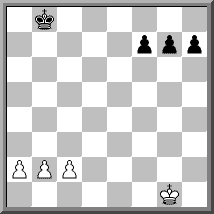Vaganian-Adamski, Copenhagen 2006
1.d4 d5 2.Nc3
I read somewhere that Vaganian has made a habit of playing the Veresov once a tournament. It seems he still does.
2...Nf6 3.Bg5 Nbd7 4.Qd3!? (Dia)
 This isn't how my first chess coach taught me to play the opening. Nevertheless this move has been played by some strong GMs and prepares e4. I have tested it in a few blitz games and I often am annoyed that it is hard to employ my light-squared bishop anywhere more active than on e2.
This isn't how my first chess coach taught me to play the opening. Nevertheless this move has been played by some strong GMs and prepares e4. I have tested it in a few blitz games and I often am annoyed that it is hard to employ my light-squared bishop anywhere more active than on e2.In order to keep your repertoire consistent it is natural to combine this line with the related 3...c6 4.Qd3.
4...c5!?
The other critical move is 4...h6 when 5.Bf4!? seems more promising than 5.Bh4. Against quieter moves I believe White can reasonably expect an advantage (although a minor one).
5.0–0–0!?
Can this really be the move that saves the Veresov? White's most popular move has been 5.Bxf6 but I find it hard to believe that giving up the bishop-pair for so little visible compensation can promise any advantage. A more likely candidate is 5.e4 but it doesn't seem to give any edge either.
5...cxd4
It seems logical to make White's queen move again. After 5...e6 two recent games continued:
a) 6.Nf3 cxd4 7.Qxd4 h6 8.Bxf6 Qxf6 9.e4 Qxd4 10.Nxd4 dxe4 11.Ndb5 Kd8 12.Nxe4 a6 13.Nbd6 Bxd6 14.Nxd6 Ke7 15.g3 += Sirin-Swiercz, Gaziantep 2008.
b) 6.e4 dxe4 7.Nxe4 Qa5 8.Bxf6 gxf6 9.Kb1 f5 10.Nxc5 Nxc5 11.dxc5 Bxc5 12.f4 0–0 13.Nf3 Be7 14.g4!? Barhudarian-Eidelson, St Petersburg 2007.
6.Qxd4 e5
After 6...e6 7.e4 these are relatively recent encounters:
a) 7...dxe4 8.Nxe4 Qa5? 9.Bxf6 gxf6?! (9...e5 offers more resistance) 10.Nxf6+ Nxf6 11.Qxf6 Rg8 12.Bb5+ 1–0 Hector-Kirkegaard, Copenhagen 2006.
b) 7...Bc5 8.Qd3 d4 9.Na4 b6 10.f4 Qc7 11.e5 Nd5 12.Nf3 h6 13.Bh4 Bb7 14.Nxd4 Nxf4 15.Qd2 (15.Qc3) 15...Bxd4 16.Qxd4 Nd5 (16...g5) 17.Bg3 0–0 18.Bd3 Rfc8 =+ Andrzejewska-Koziak, Koszalin 2005.
7.Qa4 d4 8.Nd5 (Dia)
 This position reminds of the one arising after 4.f3?! c5 5.e4 cxd4 6.Qxd4 e5 7.Qa4 which I used to play quite frequently a dozen years ago. In that line White has one more move (f3+e4 instead of 0-0-0) as his queen got to d4 in one move. However, as we shall see the two pawn moves may be irrelevant.
This position reminds of the one arising after 4.f3?! c5 5.e4 cxd4 6.Qxd4 e5 7.Qa4 which I used to play quite frequently a dozen years ago. In that line White has one more move (f3+e4 instead of 0-0-0) as his queen got to d4 in one move. However, as we shall see the two pawn moves may be irrelevant.7...Be7
It looks normal to break the pin. The alternatives are:
a) 8...Bd6 probably should be met by the immediate 9.f4.
b) Rybka likes 8...b5!? 9.Qxb5 Rb8 which gives Black a lot of play for the pawn.
9.Nxe7 Qxe7 10.f4!
This is White's idea, undermining Black's pawn centre.
10...0–0 11.fxe5
11.Nf3 too is interesting.
11...Nxe5 12.Nf3
12.Qxd4 Bf5 13.Nf3 Neg4 14.Qf4 Bxc2!? 15.Kxc2 Rfc8+ 16.Kb1 Nf2 is very unclear.
12...Nc6 13.Nxd4 Nxd4 14.Qxd4 (Dia)
 With opposite castling the position is very hard to assess but it seems to me that White must be somewhat better. However, I am not sure I would be happy to play the white pieces in a practical game.
With opposite castling the position is very hard to assess but it seems to me that White must be somewhat better. However, I am not sure I would be happy to play the white pieces in a practical game.14...Bf5 15.Bxf6 gxf6 16.e4 Rfd8 17.Qe3 Rxd1+ 18.Kxd1 Qxe4?!
With the queens off White's better pawn structure must count for something. I would have been more worried about 18...Qe6.
19.Qxe4 Bxe4 20.Bd3 Rd8 21.Ke2 Bxd3+ 22.cxd3
This position too is hard to evaluate but the only question is how large White's advantage is. His passed pawn may well be decisive.
22...Kg7 23.Rc1 Rd7 24.Rc5 Kg6 25.g4 b6 26.Rb5 Rd4 27.h3 Ra4 28.a3 Ra5 29.Rxa5 bxa5 30.Ke3 f5 31.Kf4 fxg4 32.hxg4 Kf6 33.a4 h6 34.d4 Ke6 35.Ke4 Kd6 36.d5 f6 37.Kd4 a6 38.b3 Kd7 39.Kc5 f5 40.gxf5 h5 41.Kd4 h4 42.Ke4 h3 43.Kf3 1–0


